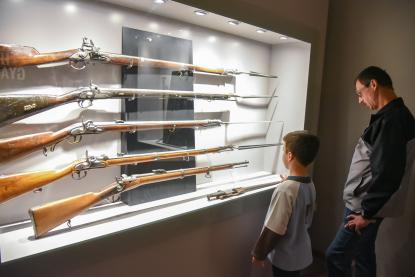2024. November 21. Thursday
István Dobó Museum - Eger
|
|
Address: 3300, Eger Vár 1.
Phone number: (36) 312-744
E-mail: varmuzeum@egrivar.hu
Opening hours: Castle: 07.11-28.02.: Mon-Sun 9-18, 01.03-06.11.: Mon-Sun 9-22
Exhibitions: 07.11-28.02.: Tue-Sun 10-16, 01.03-06.11.: Mon-Sun 10-18 |
Museum tickets, service costs:
|
Individual ticket for adults
|
2000 HUF
|
|
|
Individual ticket for adults
|
1000 HUF
|
|
|
Individual ticket for students
|
1000 HUF
|
|
|
Individual ticket for pensioners
|
500 HUF
|
|
|
Individual combined ticket for adults
(István Dobó Museum + Géza Gárdonyi Memorial Museum)
|
2400 HUF
|
|
|
Individual combined ticket for students
(István Dobó Museum + Géza Gárdonyi Memorial Museum)
|
1200 HUF
|
|
|
Individual combined ticket for students
(István Dobó Museum + Géza Gárdonyi Memorial Museum + Sándor Ziffer Gallery)
|
1400 HUF
|
|
|
Individual combined ticket for pensioners
(István Dobó Museum + Géza Gárdonyi Memorial Museum)
|
1200 HUF
|
|
|
Individual combined ticket for pensioners
(István Dobó Museum + Géza Gárdonyi Memorial Museum + Sándor Ziffer Gallery)
|
1400 HUF
|
|
|
Individual combined season ticket for a year for adults
(István Dobó Museum + Géza Gárdonyi Memorial Museum + Sándor Ziffer Gallery)
|
2800 HUF
|
|
|
Group guide for adults
|
500 HUF
|
/ capita
|
|
Group guide for students
|
300 HUF
|
/ capita
|
|
Group guide for pensioners
|
300 HUF
|
/ capita
|
|
Group guide
|
6000 HUF
|
/ group
|
|
Group guide
|
12000 HUF
|
/ group
|
|
Individual wedding photographs
|
12000 HUF
|
A new interactive exhibition has opened in the Dobó Bastion, focusing on the pieces of the Péterváry-collection purchased by the support of the Hungarian National Bank's “Értéktár” programme, complemented by the items of our museum’s collection.

Chronologically and geographically, the collection covers a wide range of weapons from the Middle Ages to the World War I, from Europe to Africa and the Middle East. In addition to the Ottoman weapons and the contemporary Hungarian arms, that form the backbone of the collection, the exhibition also seeks to interpret the development of weaponry and the revolutionary impact of gunpowder.

Chronologically and geographically, the collection covers a wide range of weapons from the Middle Ages to the World War I, from Europe to Africa and the Middle East. In addition to the Ottoman weapons and the contemporary Hungarian arms, that form the backbone of the collection, the exhibition also seeks to interpret the development of weaponry and the revolutionary impact of gunpowder.
